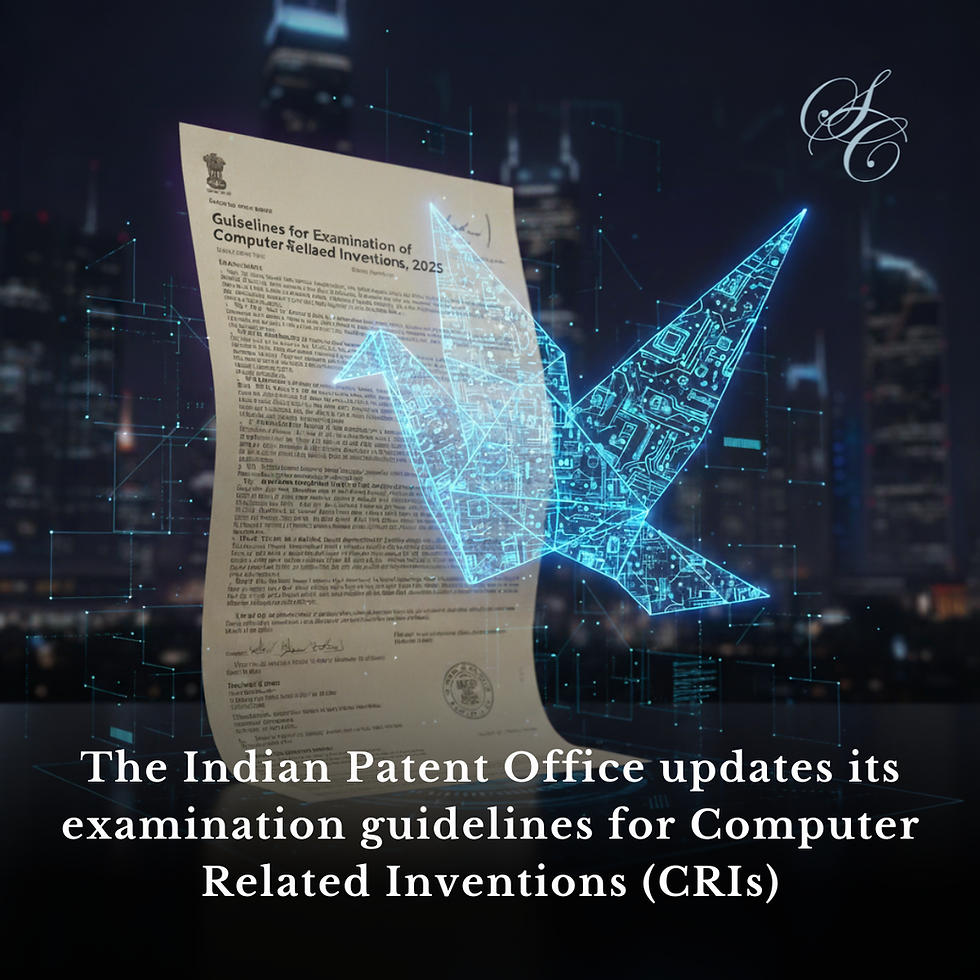Analyzing the concept of IPRs in creations of AI – Part 2: Granting Legal Personality to AI for purp
- Sarwajeet Singh
- Oct 29, 2021
- 5 min read
Our Associate, Rishikaa discusses “Analyzing the concept of IPRs in creations of AI – Part 2: Granting Legal Personality to AI for purposed of IP law – A World View”
This post is the second of the four-part series on Artificial Intelligence (“AI”) and its affair with Intellectual Property (“IP”) Law. The first part of the article series can be accessed here. Focusing on the recent developments on the world stage, this blog seeks to explore the stand taken by various jurisdictions that are contemplating the possibility of granting legal personality to AI for the purposes of intellectual property law.
While AI appears to be a recent phenomenon, the world was introduced to the concept of AI robots in the early 1900s in the book and film, the Wizard of Oz. A few years later, Alan Turing, a British polymath, brought fiction to reality and mathematically explored the possibility of AI in his 1950 paper “Computing Machinery and Intelligence”.[1]
With this background, it would be safe to say that although the concept of AI is quite old, modern day IP principles were conceived at a time when AI was only a figment of imagination and had not been envisaged from a technical, and consequently from a legal, standpoint. However, recent developments in the field of AI and its growing acceptance have compelled the legal systems of the world to reconsider the laws and the ownership of rights emanating from these laws.
With the unprecedented rate of technical advancements, artificially intelligent machines are able to imitate human behavior like never before. This imitation is bringing the ‘tech’ and ‘legal’ at crossroads with each other. At this time, legal experts are still trying to decide which side they are on in the AI vs. Humans debate. However, one recent development that has caused a stir and has taken the global community by surprise is the patent issued by South African Patent Office designating an artificial intelligence tool, called DABUS, as an inventor.[2]
DABUS is an AI system created by the CEO of Imagination Engines, Stephen Thaler, who had filed patent applications in 17 jurisdictions, naming DABUS as the sole inventor.[3] Two days after the South African grant, the Federal Court of Australia allowed DABUS to be listed as an inventor and held that the Australian Patents Act permits recognition of a non-human inventor, however such an inventor can neither be the applicant nor a grantee of a patent.[4] The court also opined that it would be a fallacy to state that only a human can be an inventor.
Although there seems to be a consensus in the views of the Patent office of South Africa and the Australian court, what’s fascinating to note is that the Australian Patent Office had rejected Thaler’s application, which was later reversed by the Federal Court. On the other hand, South Africa is a non-examining country, meaning that it does not examine patent applications based on recognized principles of patent law. Thus, many are questioning the viability of the South African recognition.
Moreover, IP offices in the UK, the EU, and the USA seem to be on the same page as the Australian Patent Office and have rejected Thaler’s application in the examination stage for the lack of identifying a human or natural inventor. Concurring with the UKIPO, the England and Wales High Court held that AI is not a natural person and does not have a legal personality, and hence cannot be granted any rights under the UK Patents Act 1977.[5]
As far as the USA is concerned, the USPTO issued a notice requiring identification of an inventor in the DABUS application, after analyzing case law, the Manual of Patent Examining Procedure and current law, and held that the current laws and regulations do not provide inventorship to non-human entities.[6] Just like Australia, Thaler’s legal team challenged the decision of USPTO before the Virginia Federal Court and submitted that the statutes, on which the USPTO relied, were passed much before the AI era and that if the Congress had contemplated the issue then it would have included AI within the definition of inventors.[7] The judge sided with the USPTO and stated that the Congress defined an inventor in 2011 through the America Invents Act. She further opined that AI has not yet reached the level of sophistication needed to be recognized as an inventor and the Congress will take the decision regarding expanding the scope of patent law to include AI as an inventor when the technology evolves to the required level of sophistication.
The Indian Copyright Office, also seems to have followed suit as it had rejected a copyright application which listed the AI application, RAGHAV, as the sole author of the work. However, it later recognized RAGHAV as the co-author along with the lawyer who owns RAGHAV.[8]
While IP offices of US, UK and Australia, arguably the most sought-after IP offices for development and interpretation of IP laws and principles, require the human element for IP registrations, it appears that the legislators of these jurisdictions as well as some courts are yet to take a call. Recently, a Chinese court recognized a non-human entity as the author of an article, only upon being satisfied that the work was created by the overall intelligence and under the supervision of multiple teams. On the legislative front, China, in its 15-year plan on developing IP, recently announced its endeavor to accelerate legislation on artificial intelligence and improvements to be made to rules protecting IP of algorithms, business models and AI outputs.[9]
As far as European Union is concerned, while the EU has introduced a comprehensive draft legislation namely, the Artificial Intelligence Act 2021, this legislation fails to address the question of IP and its relationship with AI. Interestingly, the EU Parliament had adopted a resolution regarding IP protection for development of AI in late 2020, much before proposal of the AI Act was finalized.[10]
Only time will tell how, if at all, the legislators respond to the issues surrounding AI or if they’ll leave it to the courts to analyze the situation on a case-to-case basis.
Having said this, it is pertinent to note that we have already reached a point where music scientists and composers have been able to achieve the unthinkable and complete Beethoven’s unfinished symphony with the help of AI[11]. Such developments indicate that the legal systems of the world need to buckle up and need to address the concerns surrounding AI in general and its intersection with IP. While it is understandable that time is needed to resolve the complexities pertaining to AI, considering the unprecedented rate of growth at which developments are taking place in this field, solutions are required sooner than later.
The penultimate and the final part of this blog series, will look into some of these issues and explore potential solutions to these issues.
[1] Brian McGuire, The Turing Test, University of Washington, December 2006, https://courses.cs.washington.edu/courses/csep590/06au/projects/history-ai.pdf.
[2] Ed Conlon, DABUS: South Africa issues first-ever Patent with AI Inventor, ManagingIP, July 29, 2021, https://www.managingip.com/article/b1sx9mh1m35rd9/dabus-south-africa-issues-first-ever-patent-with-ai-inventor.
[3] Utkarsh Patil, South Africa Grants A Patent with an Artificial Intelligence (AI System as the Inventor – World’s First!!, Mondaq, October 19 2021, https://www.mondaq.com/india/patent/1122790/south-africa-grants-a-patent-with-an-artificial-intelligence-ai-system-as-the-inventor-world39s-first.
[4] Thaler v. Commissioner of Patents, 2021 FCA 879.
[5] Stephen L Thaler v. The Controller-General of Patents, Designs and Trade Marks, [2020] EWHC 2412 (Pat).
[6] Decision on Application No. 16/524,350, https://www.uspto.gov/sites/default/files/documents/16524350_22apr2020.pdf?utm_campaign=subscriptioncenter&utm_content=&utm_medium=email&utm_name=&utm_source=govdelivery&utm_term= .
[7] Stephen Thaler v. Andrew Hirshfeld et al. Civil Action No. 1:20-cv-903-LMB (E.D.Va. September 2, 2021).
[8] Sukanya Sarkar, India Recognises AI as Co-Author of Copyrighted Artwork, ManagingIP, August 5, 2021, https://www.managingip.com/article/b1t0hfz2bytx44/exclusive-india-recognises-ai-as-co-author-of-copyrighted-artwork.
[9] Tian Lu, China Releases a 15-Year Blueprint on the Development of Intellectual Property Rights (2021-2035), IPKat, September 28, 2021, https://ipkitten.blogspot.com/2021/09/news-express-china-releases-15-year_28.html.
[10] Gabriele Engels, EU Artificial Intelligence Act and IP Rights, Lexology October 21, 2021, https://www.lexology.com/library/detail.aspx?g=3671fc76-6085-4db5-848a-c5888f876fce.
[11] Ahmed Elgammal, How Artificial Intelligence Completed Beethoven’s Unfinished Tenth Symphony, Smithsonian Magazine, September 24, 2021, https://www.smithsonianmag.com/innovation/how-artificial-intelligence-completed-beethovens-unfinished-10th-symphony-180978753/.




Comments